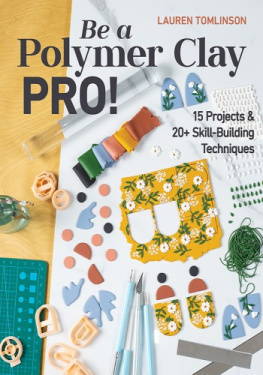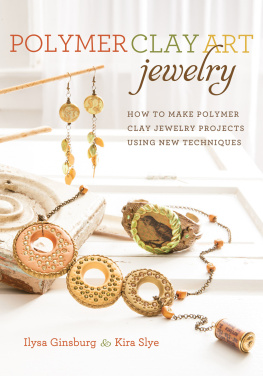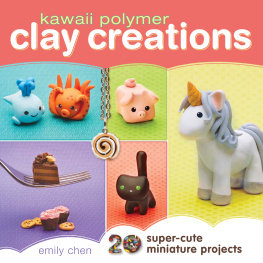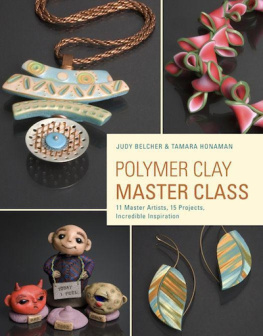ABOUT THE AUTHOR
Heidi Helyard is a leader in the popular contemporary polymer clay jewellery movement. Shes a lifelong artist, a graphic designer and innovator, and she lives near Sydney, NSW Australia.
Always creating and making things, Heidi initially favoured embroidery, weaving and other fibre arts. She discovered polymer clay in 2017 and began incorporating it into her fibre art pieces. This evolved into creating small wall hangings that morphed into wearable pendants, then came earrings and other jewellery-related objects. The progression was very organic yet quick! Heidi has now been making handmade polymer clay art and jewellery for over three years. Shes known for her constantly evolving experimental approach to working with clay, as well as for never making the same thing twice!
In 2019, Heidi launched Studio Scraps, a weekly email newsletter she sends to her subscribers that covers all kinds of topics relating to polymer clay, jewellery design and small business life. She shares lots of tips, hacks and behind-the-scenes glimpses into her studio, showing how she creates her new collections and comes up with new ideas.
Heidi considers her jewellery collections to be small-scale, one-off pieces of wearable art. Each pendant, earring or bowl is a limited edition collectable and precious, completely individual, the opposite of mass-produced fashion jewellery that floods the market. For Heidi, its about colour and texture. The beauty of polymer clay is that it presents so much opportunity for her to explore endless colour combinations, patterns and textures.
www.heidihelyard.com

ACKNOWLEDGEMENTS
Angela and Renee, thank you for your steady guidance and unbridled enthusiasm for whatever I end up doing.
Thank you Ginger Davis Allman, Wendy Moore and Cynthia Tinapple. You paved the way for me to learn, and have supported my polymer clay journey. So much generosity, wisdom and knowledge from you all. I am so grateful.
Lily, a reluctant expert on polymer clay, and a wonderful friend.
Jess, for being a soundboard and a cheerleader all at the same time.
Maya and Turner, I love you both so much.
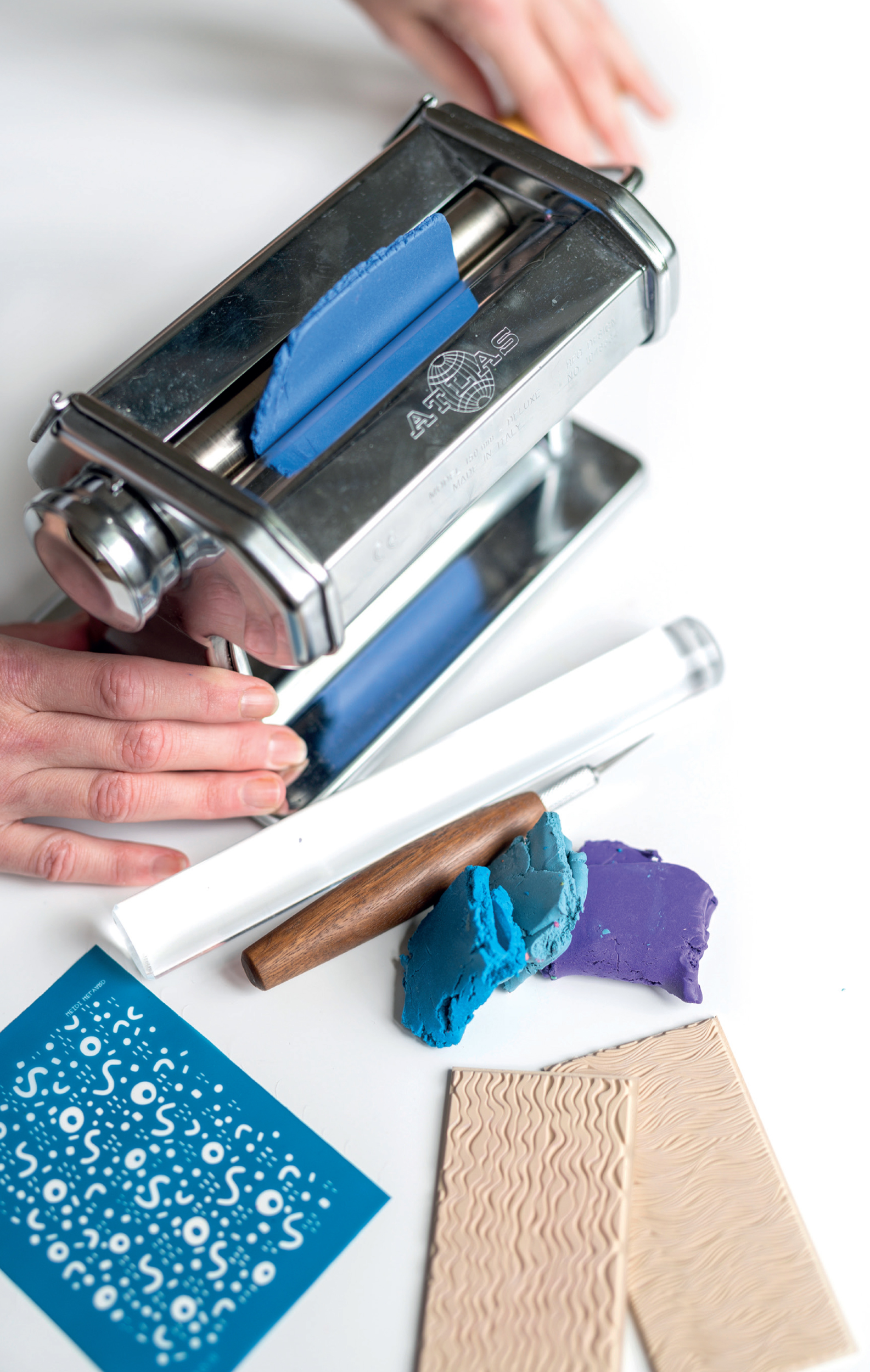
CLAY BASICS
In this section, I will be covering types of polymer clay and the main brands available. Theres advice on safety and storage too. Ill introduce the basic tool kit as well as some additional beginners tools, with a few more equipment choices to support your developing skills. To finish, theres an overview of essential techniques.
TYPES OF CLAY
Polymer clay is a synthetic modelling material formulated from polyvinyl chloride (PVC), with the addition of plasticisers to keep it pliable until it is cured using a low heat. The main terms used to describe the different types of polymer clay are detailed here:
Opaque Solid coloured clays to which dyes and pigments have been added. These are the core clay products of all brands.
Metallic Clays that mimic metals. The metallic look has been achieved by adding mica particles to translucent clay to give a sparkly effect. The final cured result is an opaque but shimmery finish. Most clay brands carry metallic clay lines, though some are more extensive than others.
Translucent Clay with no pigments added; this is used for certain techniques where translucency is desired.
Liquid Polymer clay but in a liquid form. It can be used to decorate, glaze or seal finished pieces, as well as for construction purposes.
BASIC SAFETY INFORMATION
Polymer clay is classified as a non-toxic substance but its not food safe, so here are a few important rules that should be followed:
- Do not use polymer clay to make any type of vessel or utensil that will come into contact with food.
- Do not eat while working with raw clay, and be sure to wash your hands often.
- Keep dedicated tools and equipment for polymer clay work separate and never use them to prepare food or in the kitchen.
- While curing polymer clay in your home oven is perfectly safe, do keep the area as well-ventilated as possible.

CLAY BRANDS
Small blocks of polymer clay are inexpensive and easy to come by, but how do you decide which to choose when there are so many different brands available? Start by taking a look at the summary of the main brands below. Here I outline their basic properties to help you choose which ones best suit your purpose. Is it possible to mix different brands of clay that have different curing times and temperatures? The answer is yes! I often do this and simply split the difference between any variables.
Sculpey
Sculpey III Very soft and easy to condition and available in a wide variety of colours, a wonderful clay for children and beginners. When cured, however, its brittle and prone to cracking so has limitations, but can be used for decorative elements, for surface patterns and shapes on slabs, and to tint other brands of clay.
Sculpey Premo This readily available all-purpose clay is easy to condition and very strong when cured. Theres a great colour selection, including gorgeous metallics and glitters in the Premo Accents range.
Sculpey Souffl Lightweight yet very strong, this clay has a matte finish, which is great for hiding fingerprints! The range has a lovely yet limited colour palette, but as there are no true colours (i.e., colours closest to primary colours, see ), its not designed for colour mixing.
Fimo
Fimo Soft This all-purpose clay is strong when cured and super versatile. It is marketed as being a softer clay than the Fimo Professional range, so easier to sculpt by beginners. It is available in many colours.
Fimo Professional This top-grade clay is incredibly strong and durable when cured, making it ideal for sculptural work, as well as cane-making and jewellery pieces. True primary colours are available, so it is designed for predictable colour mixing.
Fimo Effect This range includes some granite, glitter and coloured translucent clays.
Fimo Leather-Effect A clay that, after curing, looks and feels like leather. Cured sheets can be cut with scissors and stitched.
Cernit
Popular in Europe and known for its porcelain-like finish when cured, this clay is extremely strong and flexible. Theres a huge range of colours, spectacular metallics and granites, and Cernit Translucent is one of the best translucent clays on the market.

Kato Polyclay
A line of clay developed by American polymer clay artist, Donna Kato; it offers a range of bright, muted and metallic colours, with true primary colours designed for colour mixing. When cured it is one of the strongest clays available.


